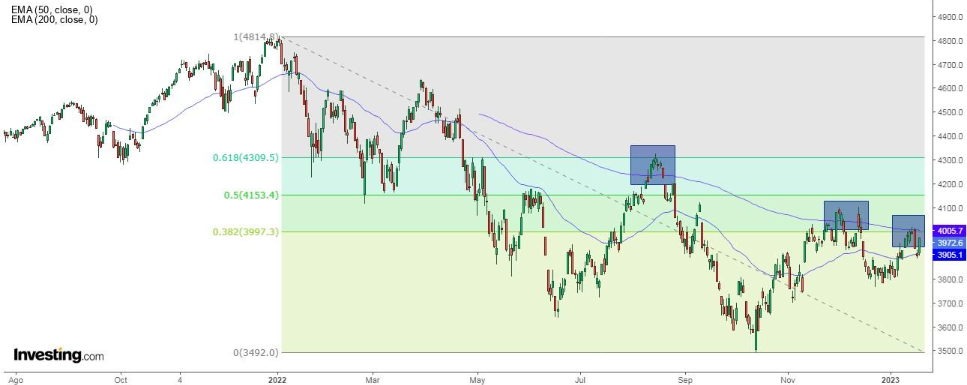- After a terrible 2022, the S&P 500 is off to a positive January
- However, the benchmark index is yet to break out of its 200-day moving average
- Here are the main technical levels to watch out for
Despite last week's increased volatility, the S&P 500 remains in positive territory in 2023. But while the macro environment seems to have improved on some fronts, i.e., U.S. inflation, energy pressures in Europe, and lowering global recession odds, it remains too early to call victory.
So, as traders begin to see a possible way out of last year's dismal market, here are two things to keep in mind when trading the S&P 500:
1. It Still Hasn't Broken Out of its 200-Day Moving Average
It failed in March 2022, in August 2022, in December 2022, and now in January 2023. On some of these occasions, there was a false breakout where it began to overcome the average but ultimately went lower.
In some European indexes, a bullish signal called a golden crossover was formed, which is when the 50-day moving average crosses above the 200-day moving average. But in the case of the S&P 500, it was not triggered.
As long as it remains above 3,783 points, there will be no problems. But for a rally, it must break above the 200-day moving average.
2. Support and Resistance Zones
Plotting Fibonacci levels up to the relevant low (October 2022) we obtain a series of zones that generally act as upside targets and resistance zones.
The first zone was reached in November 2022 and was the first upside target, also acting as resistance. The second zone or second medium-term upside target is at 4,150 points.
Investor sentiment (AAII)
- Bullish sentiment, i.e. expectations that stock prices will rise over the next six months, increased 6.9 percentage points to 31%. It still remains below its historical average of 37.5%.
- Bearish sentiment, i.e. expectations that stock prices will fall in the next six months, fell 6.9 percentage points to 33.1%. This is the first time since August 2022 that bearish sentiment has been below 40% in consecutive weeks. It remains above its historical average of 31%.
Dow Jones U.S. Dividend 100 continues to outperform the Dow Jones in all time periods
Many investors are probably not familiar with the Dow Jones Dividend 100 and Dow Jones International Dividend 100 indexes.
I am going to explain what they are because they have performed well relative to their benchmarks in 2022, and that too with a backdrop of rising interest rates, increased geopolitical risks, and slowing economic growth.
Both indexes use a rigorous screening process when selecting their constituents with a series of criteria, including value, growth and, above all, quality.
They can only include companies that have paid dividends for at least 10 consecutive years. The stocks are then ranked according to their annualized dividend yield and finally the top 100 stocks are selected on the basis of the overall score.
Their yields are very interesting, especially in the case of the Dow Jones US Dividend 100, which beats the Dow Jones in virtually every period.
| Index |
3 years |
5 years |
10 years |
15 years |
|
DJ US Dividend 100 |
+13,18% |
+11,79% |
+13,84% |
+11,02% |
|
DJ International Dividend |
+6,15% |
+6,06% |
+7,23% |
+5,34% |
Global Stock Market Ranking 2023
The ranking of the major stock exchanges based on gains/losses so far in 2023 goes as follows:
- Chinese CSI +9%.
- Italian FTSE MIB +8.76%.
- Euro Stoxx 50 + 9.04%
- IBEX 35 +8.65
- French CAC 40 +8.38%.
- German DAX +8.19%
- British FTSE 100 +4.62%
- Nasdaq 100 +6.44
- S&P 500 +3.47%
- Japanese Nikkei +3.11%
- Dow Jones Industrial Average +0.69%
Disclosure: The author does not own any of the securities mentioned in this article.
